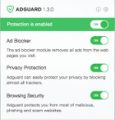What is SmartControl
SmartControl is a potentially unwanted application (PUA) that falls under the category of Adware . Adware software is considered by many to be synonymous with ‘malicious software’. It’s a malicious program which shows unwanted ads to computer users. Some examples include pop up ads, various offers and deals or unclosable windows. Adware can be installed onto your MAC OS via infected web-pages, when you open email attachments, anytime you download and install freeware.
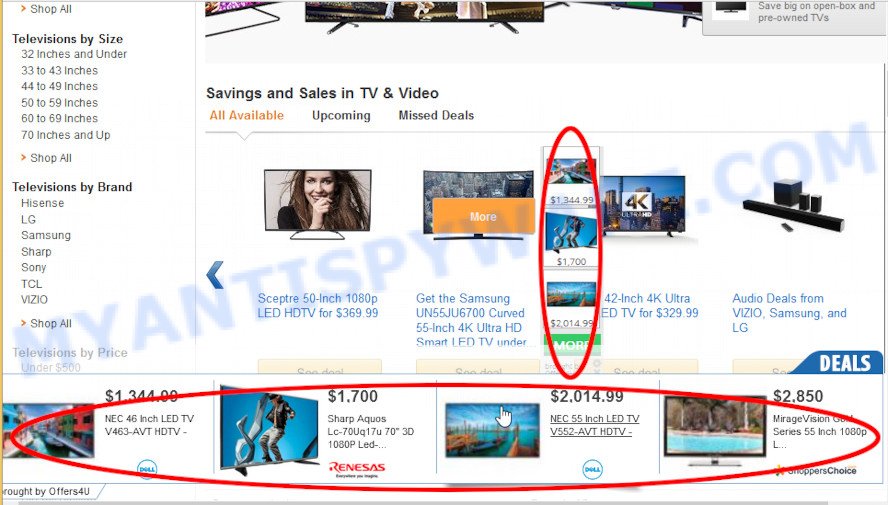
Unwanted ads
Does adware steal your privacy data? Adware software can install a component that enables its creator to track which web-sites you visit, which products you look at upon those pages. They are then able to choose the type of ads they show you. So, if you had adware on your MAC OS, there is a good chance you have another that is gathering and sharing your confidential information with third parties, without your say-so.
Below we are discussing the ways which are very useful in removing adware software. The guidance will also assist you to remove SmartControl from your MAC for free.
How does SmartControl get on your computer
The most common way to get adware is a freeware setup file. In many cases, a user have a chance to disable all third-party programs, but some installation packages are created to confuse the average users, in order to trick them into installing PUPs and adware software. Anyway, easier to prevent adware rather than clean up your Apple Mac after one. So, keep your browser updated (turn on automatic updates), use good antivirus programs, double check free software before you start it (do a google search, scan a downloaded file with VirusTotal), avoid dubious and unknown web pages.
Threat Summary
| Name | SmartControl, SmartControl 1.0 app |
| Type | adware, potentially unwanted application (PUA), popups, popup ads, pop-up virus |
| Symptoms |
|
| Removal | SmartControl removal guide |
How to remove SmartControl adware
There are several steps to deleting the SmartControl adware, because it installs itself so deeply into the Apple Mac. You need to delete all suspicious and unknown software, then delete malicious add-ons from the Firefox, Google Chrome and Safari and other web-browsers you’ve installed. Finally, you need to reset your browser settings to remove any changes the adware has made, and then scan your machine with MalwareBytes Free to ensure the adware is fully removed. It will take a while.
To remove SmartControl, use the steps below:
- Remove profiles created by SmartControl
- Check the list of installed software
- Remove SmartControl related files and folders
- Scan your Mac with MalwareBytes
- Remove SmartControl from Safari, Chrome, Firefox
- How to stay safe online
- Finish words
Remove profiles created by SmartControl
SmartControl can install a configuration profile on the Mac system to block changes made to the browser settings. Therefore, you need to open system preferences, find and delete the profile installed by the adware software.
Click Apple menu ( ![]() ) > System Preferences.
) > System Preferences.
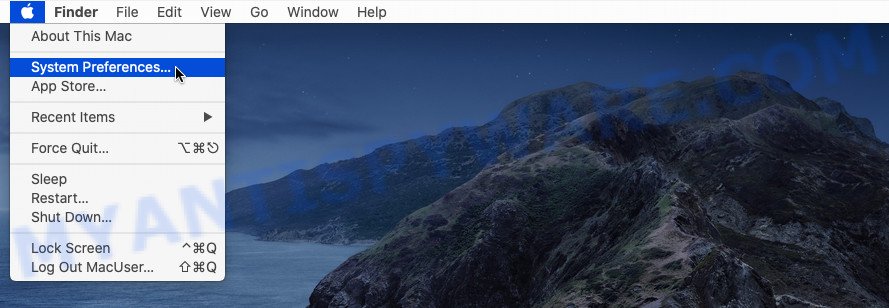
In System Preferences, select Profiles. if there is no Profiles in the list of preferences, that means there are no profiles installed on the Mac device. If there is Profiles in the list, then click on it, then select a profile related to SmartControl.
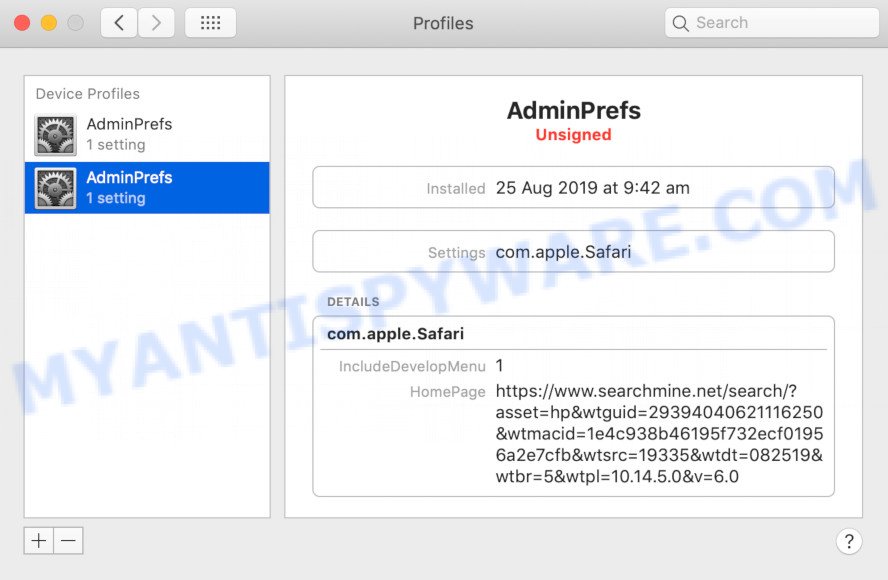
To delete a malicious profile, click on the minus button ( – ) located at the bottom-left of the Profiles screen.
Check the list of installed software
The next step to remove PUPs, adware and browser hijackers is to uninstall unknown and questionable apps. Using the Finder you can do this quickly and easily. We recommend you not to skip this step, as it often helps to get rid of web-browser redirects and undesired advertisements.
Open Finder and click “Applications” as displayed on the screen below.
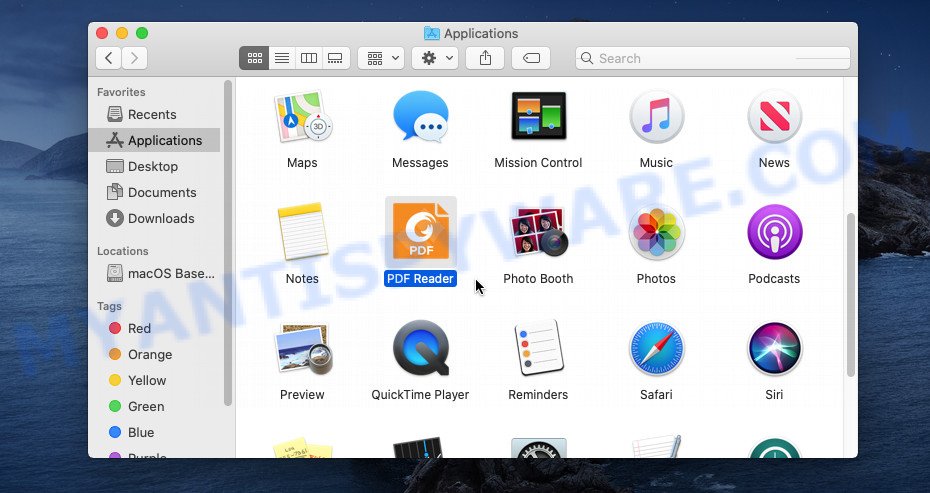
You will see a list of apps installed on your computer. We recommend to pay maximum attention to the program you installed last. Most likely, it is the SmartControl . If you’re in doubt, you can always check the application by doing a search for her name in Google, Yahoo or Bing.
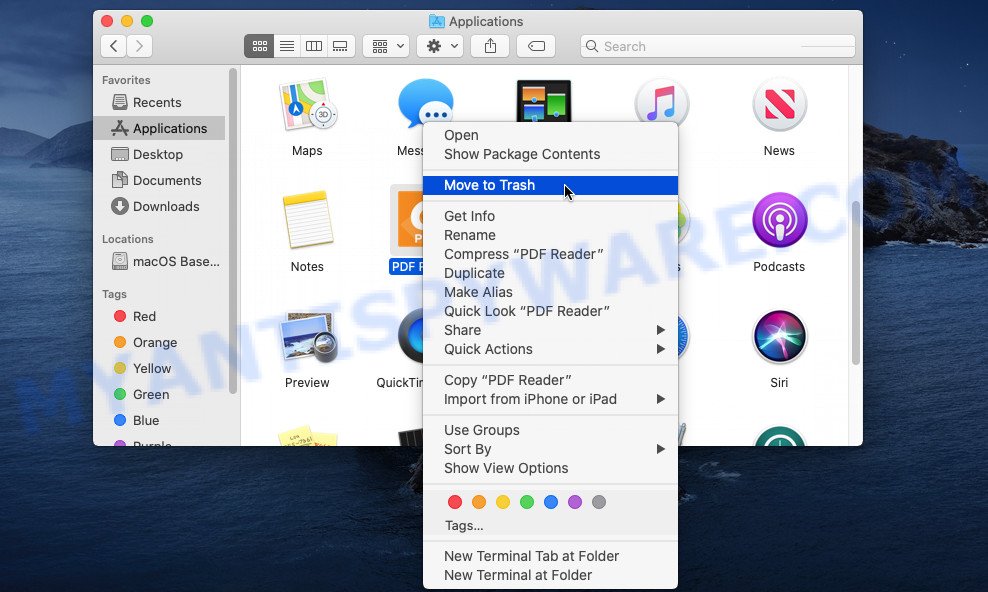
Once the program which you need to remove is found, simply right click on its name, and choose “Move to Trash”.
Don’t forget, select Finder, then “Empty Trash”.
Remove SmartControl related files and folders
Now you need to try to find SmartControl related files and folders, and then delete them manually. You need to look for these files in certain directories. To quickly open them, we recommend using the “Go to Folder…” command.
Click on the Finder icon. From the menu bar, select Go and click “Go to Folder…”. As a result, a small window opens that allows you to quickly open a specific directory.

Check for SmartControl generated files in the /Library/LaunchAgents folder

In the “Go to Folder…” window, type the following text and press Go:
/Library/LaunchAgents
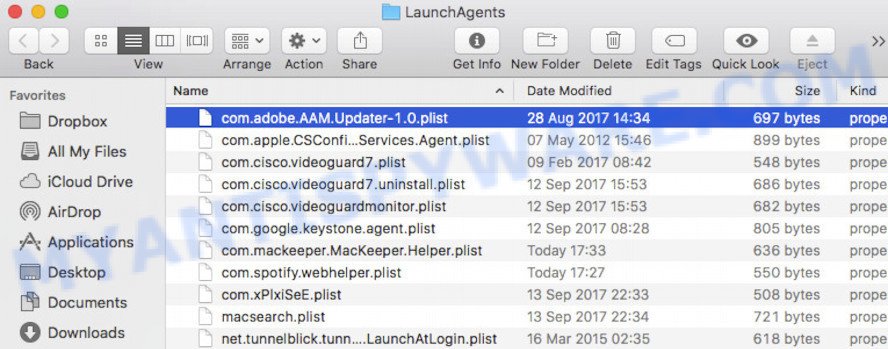
This will open the contents of the “/Library/LaunchAgents” folder. Look carefully at it and pay special attention to recently created files, as well as files that have a suspicious name. Move all suspicious files to the Trash. A few examples of files: installapp.plist, macsearch.plist, SmartControl.plist, com.machelper.plist and search.plist. Most often, PUPs, adware and browser hijackers create several files with similar names.
Check for SmartControl generated files in the /Library/Application Support folder

In the “Go to Folder…” window, type the following text and press Go:
/Library/Application Support
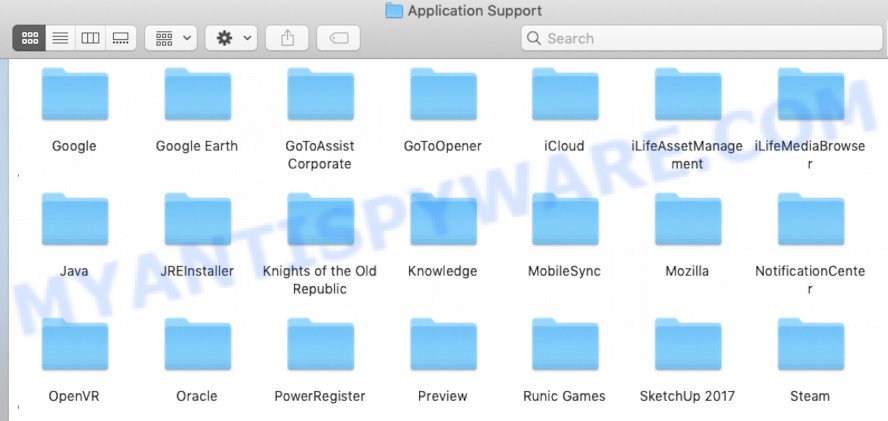
This will open the contents of the “Application Support” folder. Look carefully at its contents, pay special attention to recently added/changed folder. Move all suspicious folders to the Trash.
Check for SmartControl generated files in the “~/Library/LaunchAgents” folder

In the “Go to Folder…” window, type the following text and press Go:
~/Library/LaunchAgents

Proceed in the same way as with the “/Library/LaunchAgents” and “/Library/Application Support” folders. Look for suspicious and recently added files. Move all suspicious files to the Trash.
Check for SmartControl generated files in the /Library/LaunchDaemons folder
In the “Go to Folder…” window, type the following text and press Go:
/Library/LaunchDaemons

Carefully browse the entire list of files and pay special attention to recently created files, as well as files that have a suspicious name. Move all suspicious files to the Trash. A few examples of files to be deleted: com.macsearch.plist, com.machelper.plist, com.installapp.plist, com.search.plist and com.SmartControl.plist. In most cases, browser hijackers, PUPs and adware software create several files with similar names.
Scan your Mac with MalwareBytes
We recommend using MalwareBytes Anti Malware (MBAM) to scan the Mac device for potentially unwanted programs, browser hijackers and adware software. This free tool is an advanced malware removal program developed by (c) Malwarebytes lab. This program uses the world’s most popular anti-malware technology. It’s able to help you delete web-browser toolbars and other security threats from your Mac device for free.
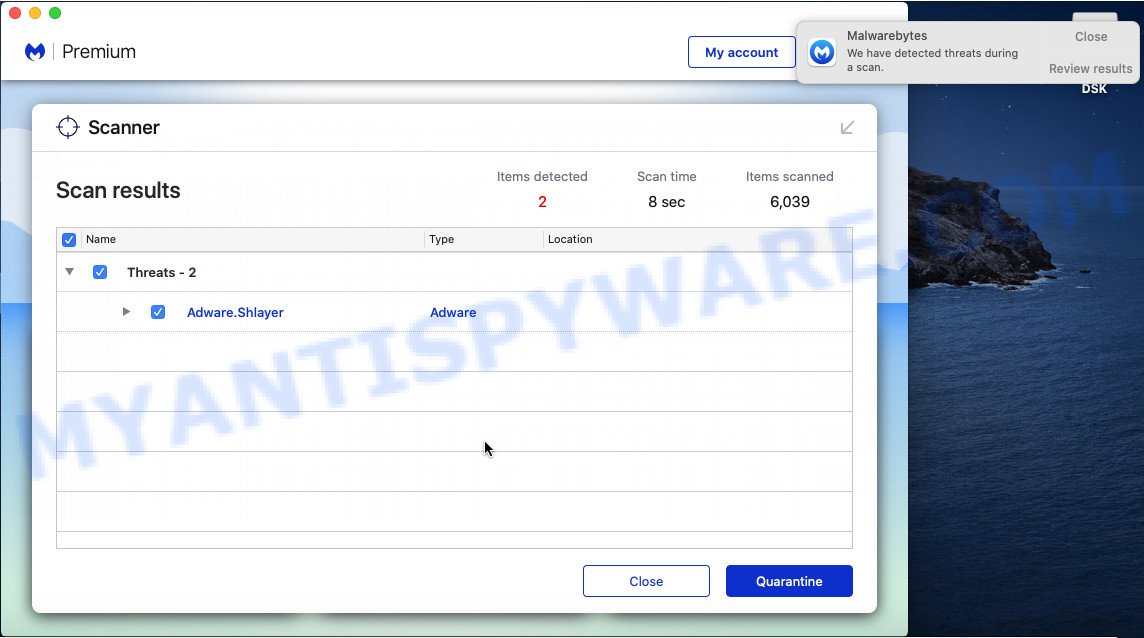
- Download MalwareBytes on your machine by clicking on the following link.
Malwarebytes Anti-malware (Mac)
21024 downloads
Author: Malwarebytes
Category: Security tools
Update: September 10, 2020
- Once the downloading process is complete, close all applications and windows on your computer. Open a file location. Run the downloaded file and follow the prompts.
- Press the “Scan” button to search for SmartControl . A scan can take anywhere from 10 to 30 minutes, depending on the count of files on your MAC system and the speed of your MAC OS. While the MalwareBytes Anti-Malware (MBAM) application is checking, you can see how many objects it has identified as threat.
- After the checking is complete, MalwareBytes Anti-Malware (MBAM) will open a list of all threats found by the scan. Review the scan results and then click “Quarantine”.
Remove SmartControl from Safari, Chrome, Firefox
This step will show you how to remove malicious add-ons. This can remove SmartControl adware and fix some surfing issues, especially after adware software infection.
You can also try to remove SmartControl by reset Google Chrome settings. |
If you are still experiencing problems with SmartControl removal, you need to reset Firefox browser. |
|
How to stay safe online
To put it simply, you need to use an ad blocker utility (AdGuard, for example). It’ll stop and protect you from harmful webpages, unwanted ads and pop-ups. To be able to do that, the ad blocking program uses a list of filters. Each filter is a rule that describes a malicious website, an advertising content, a banner and others. The ad-blocking program automatically uses these filters, depending on the web-pages you’re visiting.
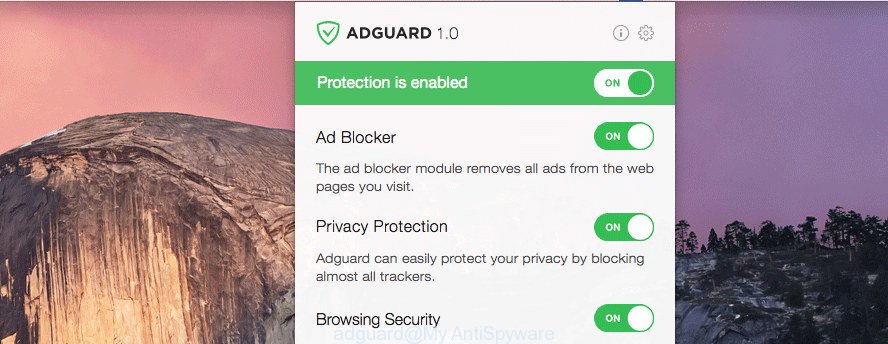
- Installing the AdGuard is simple. First you will need to download AdGuard on your Windows Desktop by clicking on the link below.
AdGuard for Mac download
3782 downloads
Author: © Adguard
Category: Security tools
Update: January 17, 2018
- When the downloading process is done, run the downloaded file. You will see the “Setup Wizard” program window. Follow the prompts.
- When the installation is done, press “Skip” to close the installation application and use the default settings, or click “Get Started” to see an quick tutorial which will allow you get to know AdGuard better.
- In most cases, the default settings are enough and you don’t need to change anything. Each time, when you launch your Apple Mac, AdGuard will start automatically and stop undesired advertisements, block malicious and misleading websites.
Finish words
Now your MAC should be free of the SmartControl adware. We suggest that you keep MalwareBytes Anti-Malware (to periodically scan your MAC OS for new adwares and other malicious software) and AdGuard (to help you stop intrusive pop up advertisements and harmful websites). Moreover, to prevent any adware software, please stay clear of unknown and third party applications.
If you need more help with SmartControl related issues, go to here.

